Evidence Requirements: Legal Standards, Types, and Admissibility
Updated On: August 24, 2025 by Aaron Connolly
Fundamental Principles of Evidence Requirements
Evidence law rests on a few core ideas that shape what courts actually consider during trials. These principles zero in on relevance, reliability, and the different kinds of evidence that can help prove or disprove what really happened.
Defining Evidence
Evidence covers anything presented in court to establish facts in a legal case. Think physical objects, documents, witness testimony, and digital materials—whatever helps paint the picture.
Rule 401 of the Federal Rules of Evidence says relevant evidence is anything that makes a fact “more or less probable than it would be without the evidence.” Courts interpret this pretty broadly.
Before courts accept evidence, it needs to meet certain requirements. The information should matter to the case and be trustworthy enough to help make good decisions.
Key evidence requirements:
- Relevance to the facts in dispute
- Proper authentication
- Compliance with hearsay rules
- Chain of custody documentation (for physical evidence)
Courts look at evidence for its probative value—how much it actually helps prove something important. Evidence with high probative value can really sway a case.
Direct Versus Circumstantial Evidence
Direct evidence proves a fact straight up, without extra reasoning. When a witness says, “I saw the defendant sign the contract,” that’s direct evidence.
Circumstantial evidence needs some logical thinking to connect it to the fact. If someone finds the defendant’s fingerprints on a contract, that suggests they handled it, but doesn’t directly prove they signed it.
Both types matter equally in court. Circumstantial evidence can be just as persuasive, especially when several pieces all point the same way.
Examples of direct evidence:
- Eyewitness statements
- Video of the event
- Audio recordings of conversations
- Confessions or admissions
Examples of circumstantial evidence:
- Fingerprints at a crime scene
- Financial records showing motive
- Timeline evidence putting someone at a location
Sometimes, circumstantial evidence ends up more reliable than direct evidence. Witnesses can mess up or lie, but physical evidence tends to stick to the facts.
Materiality in Legal Contexts
Materiality decides if evidence actually relates to something that could change the case outcome. Evidence law only allows information that’s both relevant and material.
Material evidence can affect the result by proving or disproving key legal points. For example, in a contract dispute, evidence about what the parties intended matters because it shapes how the contract gets interpreted.
Courts ask themselves:
- Does this evidence connect with legal issues in the case?
- Could this information make a difference in the decision?
- Is this evidence necessary to prove or disprove a claim?
Courts toss out non-material evidence, even if it’s technically relevant. Stuff about a defendant’s character might be interesting, but if character isn’t on trial, it doesn’t belong.
Materiality requirements help by:
- Cutting down on time spent on side issues
- Preventing jury overload
- Avoiding unfair prejudice
- Keeping trials from getting bogged down in details
Courts juggle materiality with other factors like prejudice or confusion, aiming for fair trials.
Establishing Relevance and Admissibility
Courts use specific tests to figure out if evidence should come in at trial. The Federal Rules of Evidence lay out the standards for what counts as relevant and admissible.
Test for Relevance and Rule 401
Rule 401 gives a simple test for relevant evidence. Evidence is relevant if it checks two boxes.
First, it must be probative—does it make a fact more or less likely than it would be without it?
Second, the fact has to actually matter in the case.
The bar is pretty low. Evidence doesn’t need to prove something outright—it just has to nudge the probability.
Key points about relevance:
- Both direct and circumstantial evidence can be relevant
- Background info that helps understanding usually counts
- The fact doesn’t have to be disputed to matter
- Things like charts, photos, and physical evidence usually pass this test
For instance, if someone bought a gun right before a shooting, that fact seems pretty relevant. It makes it more likely they were involved.
Exclusion Under Rule 403
Judges can toss out even relevant evidence under Rule 403 if its downsides outweigh its value.
Judges might exclude relevant evidence if it brings:
- Unfair prejudice—evidence that could sway the jury for the wrong reasons
- Confusion of issues—evidence that distracts from the real questions
- Misleading the jury—evidence that could be misunderstood
- Undue delay—evidence that wastes time
- Waste of time—evidence that doesn’t add much
- Needless repetition—evidence that just repeats what’s already been shown
The judge balances the evidence’s value against these risks. If the risks are way bigger, out it goes.
This process keeps technically relevant but unfair or confusing evidence out of trials.
Standards for Admissible Evidence
Rule 402 says relevant evidence is in—unless a law or rule says otherwise.
Sources that can keep out relevant evidence:
- The Constitution
- Federal statutes
- The Federal Rules of Evidence
- Other Supreme Court rules
Irrelevant evidence never gets in, no matter what.
The party who wants to use evidence has to show it meets the relevance test. Once that’s done, it’s usually in.
The other side has to argue why an exclusion rule should keep it out. Typical reasons include hearsay, privilege, or constitutional issues.
This setup leans toward letting juries hear relevant stuff, unless there’s a strong reason not to.
Authentication and Proof of Authenticity
Courts want to know evidence is the real deal before it comes in. Federal Rule of Evidence 901 sets the bar, requiring proper identification and authentication through witness testimony, expert analysis, or other reliable methods.
Methods of Authentication
Rule 901 lists ten ways to authenticate evidence. The most common? Witness testimony from someone with direct knowledge.
For documents, courts allow a few routes. A witness might say they saw the document made or signed. Handwriting comparison works if someone familiar with the writing can recognize it.
Distinctive features can help too. If a letter mentions private details only the sender would know, that’s a clue. Phone calls get authenticated when someone dials a known number and talks business.
Public records need less fuss. Courts usually accept them if they come from the right office. Ancient documents (over 20 years old) get special treatment—if they’re found in the right place and look untampered, courts usually let them in.
Digital evidence follows similar rules, but it’s trickier. We have to show the systems and processes work reliably.
Role of Expert Witnesses
Expert witnesses matter a lot for complex evidence. They analyze handwriting, voice recordings, and digital files using their specialized knowledge.
Handwriting experts compare documents with known samples. They look at letter shapes, spacing, and pressure. Voice ID specialists use tech to analyze speech patterns.
Digital forensics experts authenticate electronic evidence. They check computer processes, look at metadata, and trace file origins. They need to show their methods are trustworthy.
Courts don’t require experts for simple stuff. Anyone familiar with someone’s handwriting can give an opinion, as long as they didn’t learn it just for the case.
Witness Testimony for Authenticity
Witness testimony is still the backbone of authentication. Anyone with direct knowledge can confirm evidence they saw or handled.
A witness might say they watched someone sign a contract or snap a photo. Chain of custody testimony tracks evidence from collection to courtroom, making sure it wasn’t changed.
The witness doesn’t need expert status. Regular folks can recognize voices, handwriting, or objects they know from everyday life. They just can’t have learned it for the trial.
Phone conversations need extra steps. The witness should explain how they knew who was talking. Just hearing “It’s me” isn’t enough—something else has to back up the ID.
Types of Evidence in Legal Proceedings
Courts accept three main kinds of evidence to prove facts. Physical stuff needs careful handling, documents have to be authenticated, and digital evidence requires computer forensics to check it’s legit.
Physical and Real Evidence
Physical evidence is any real object you can touch and examine in court. Weapons, clothing, fingerprints, DNA samples—if it’s tied to the case, it counts.
Chain of custody is everything for physical evidence. Everyone who touches the item has to record when they got it, what they did with it, and who got it next.
Courts usually reject physical evidence if there are gaps in the chain. We need a full record from the scene to the courtroom.
Common examples:
- Weapons from crimes
- Blood samples for DNA
- Clothes with damage or stains
- Photos of accident scenes
- Fingerprints from surfaces
The evidence must be related to the case and kept safe. If it gets contaminated or stored wrong, it might not be usable.
Documentary Evidence
Documentary evidence covers written stuff that backs up legal arguments. Contracts, letters, medical records, business docs, official certificates—all of these can play a part.
Authentication is the big hurdle here. We need to show the document is legit and hasn’t been messed with.
Courts use the Best Evidence Rule for documents. They want the original, not a copy, whenever possible.
Key types of documentary evidence:
- Contracts and agreements
- Medical records and test results
- Business records and financials
- Government certificates and licenses
- Personal letters and notes
Handwriting experts sometimes verify signatures. Sometimes, a witness who saw the document made or signed can help too.
Digital and Electronic Evidence
Digital evidence includes emails, texts, social media posts, computer files, and electronic data. This stuff has exploded as tech’s taken over.
Computer forensics experts are crucial here. They pull data from devices and check that nothing’s been tampered with.
Courts struggle with digital evidence because it’s so easy to fake. We need tech experts to explain how it was collected and kept safe.
Common digital evidence:
- Emails between parties
- Text and instant messages
- Social media posts and photos
- Computer files and browsing records
- GPS data and location tracking
Metadata can help prove a file’s authenticity by showing when it was made or changed. Timestamps and digital signatures add extra proof for electronic docs.
Chain of Custody and Evidence Integrity
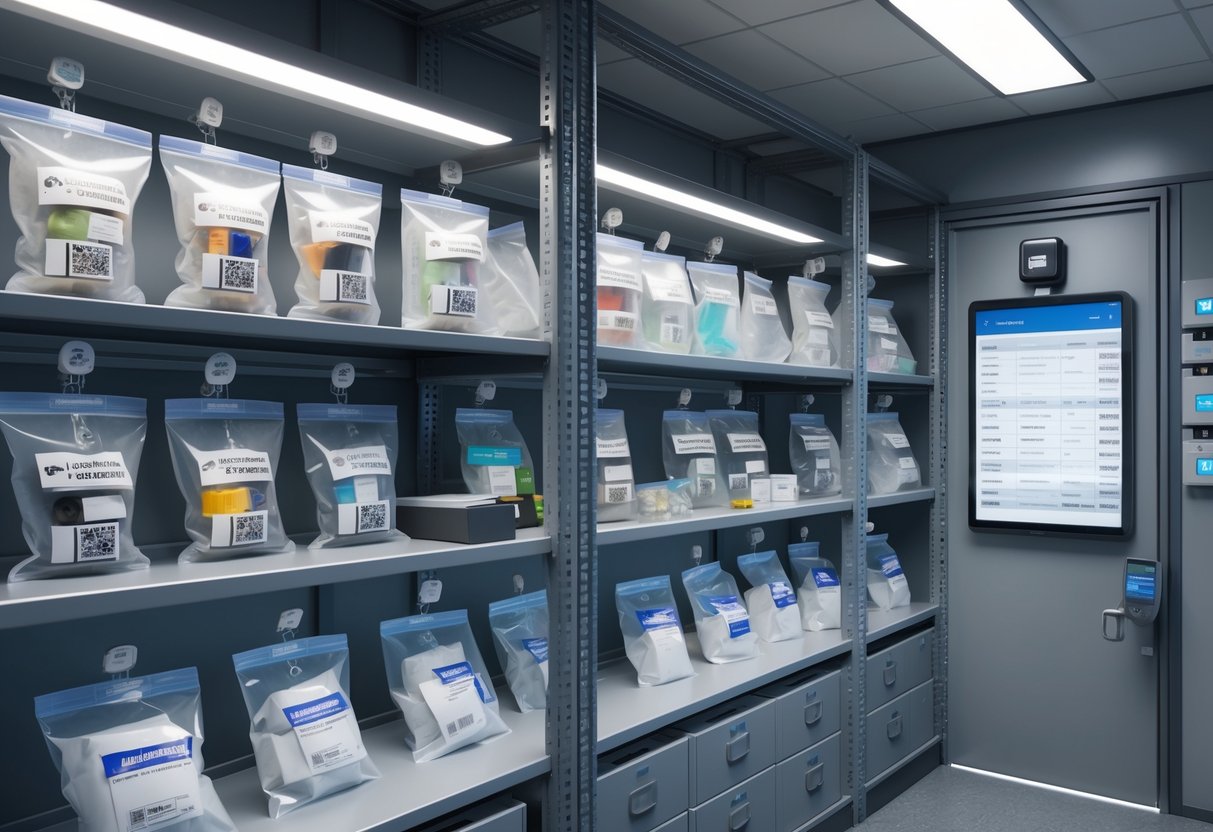
Proper evidence handling keeps a clear record from collection to courtroom. This means strict documentation and tamper-evident steps that protect the evidence’s authenticity.
Documenting Handling and Transfers
Every piece of evidence needs careful documentation at each step. We note who collected the evidence, when they collected it, and where it came from.
Essential Documentation Elements:
- Collector’s name and credentials
- Date, time, and location of collection
- Detailed description of evidence
- Unique identification numbers
- Storage conditions and requirements
Transfer documentation matters a lot in criminal and civil cases. Each time someone hands off evidence, both people sign for it.
We write down the reason for each transfer and note any changes in the evidence’s condition.
Transfer Protocol Requirements:
- Written transfer forms with signatures
- Sealed evidence containers
- Chain of custody logs
- Access control records
Digital evidence brings its own headaches. We create forensic images and log every access attempt.
Electronic logs track timestamps and user identities for all interactions.
Storage facilities keep entry and exit logs. These records show exactly who accessed evidence and when.
Security cameras often back up these records, adding another layer of verification.
Tamper-Evident Protocols
Tamper-evident measures help protect evidence from unauthorized access or contamination. We rely on specialized seals, containers, and storage methods that make any interference obvious.
Physical Evidence Protection:
- Signed security seals across container openings
- Tamper-evident tape with unique identifiers
- Controlled environment storage
- Limited access protocols
We use several security steps for evidence bags and containers. Seals break when someone opens them and can’t be replaced without leaving a trace.
Each seal has a unique ID number tied to the case records.
For digital evidence, we use blockchain or similar systems. These tools create permanent records of all access attempts.
Hash values confirm that digital files haven’t changed during custody.
Digital Security Measures:
- Cryptographic hash verification
- Access logs with timestamps
- Secure server storage
- Regular integrity checks
Criminal cases get more scrutiny than civil ones when it comes to handling evidence. Courts might toss out evidence if there are gaps in the chain of custody or any signs of tampering.
We regularly audit evidence storage areas. These inspections help us make sure our security protocols still work.
Quality control checks let us spot weaknesses before they threaten evidence integrity.
Burdens and Standards of Proof
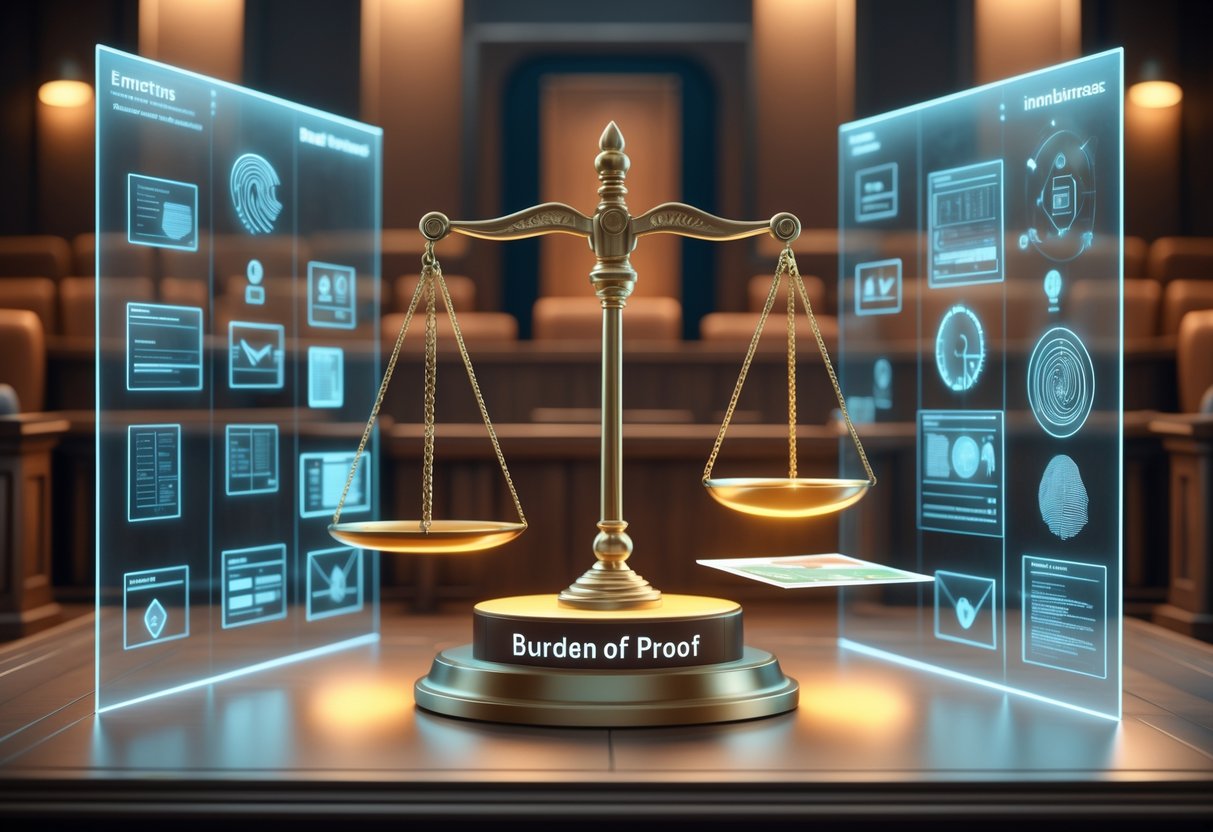
Civil cases usually use a preponderance of the evidence standard, while criminal matters demand proof beyond a reasonable doubt. These requirements match the stakes in each type of case.
Burden of Proof in Civil Cases
In civil cases, the burden of proof sits with the plaintiff. They need to give enough evidence to convince the judge or jury their version of events is right.
The standard is called preponderance of the evidence. Plaintiffs must show their claim is more likely true than not—think of it as a 51% chance.
Key features of civil proof standards:
- Lower threshold than criminal cases
- Focuses on what probably happened
- Both sides present evidence
- Plaintiff carries initial burden
Some civil cases use a higher standard: clear and convincing evidence. This usually applies to serious issues like fraud or custody disputes.
This standard asks for much more proof than preponderance. The evidence must show a high chance that the facts are true.
Proof in Criminal Matters
Criminal cases set the bar much higher because a person’s freedom is at risk. The prosecution has to prove guilt using the strictest standard of proof.
In criminal cases, the prosecution holds the entire burden. They must show evidence for every element of the alleged crime.
The defendant doesn’t have to prove innocence. They can just poke holes in the prosecution’s case or offer other explanations.
Criminal proof requirements include:
- Prosecution carries entire burden
- Must prove every element of crime
- Higher evidence standards required
- Defendant presumed innocent
Police investigations use different standards. Probable cause lets them search or arrest. Reasonable suspicion allows for traffic stops and short detentions.
Beyond a Reasonable Doubt Standard
Beyond a reasonable doubt is the highest evidence standard in our legal system. The prosecution must rule out reasonable alternative explanations for the evidence.
This doesn’t require absolute certainty. Courts often call it “moral certainty,” not mathematical proof.
This standard protects innocent people from wrongful conviction. Jurors have to feel firmly convinced of guilt before they can convict.
What this standard requires:
- Only logical explanation is defendant’s guilt
- No reasonable alternative theories
- Firm conviction, not absolute certainty
- Higher than civil standards
If the jury has reasonable doubt about any part of the crime, they must find the defendant not guilty. This high bar helps keep criminal trials fair when liberty is at stake.
Rules of Evidence and Legal Frameworks
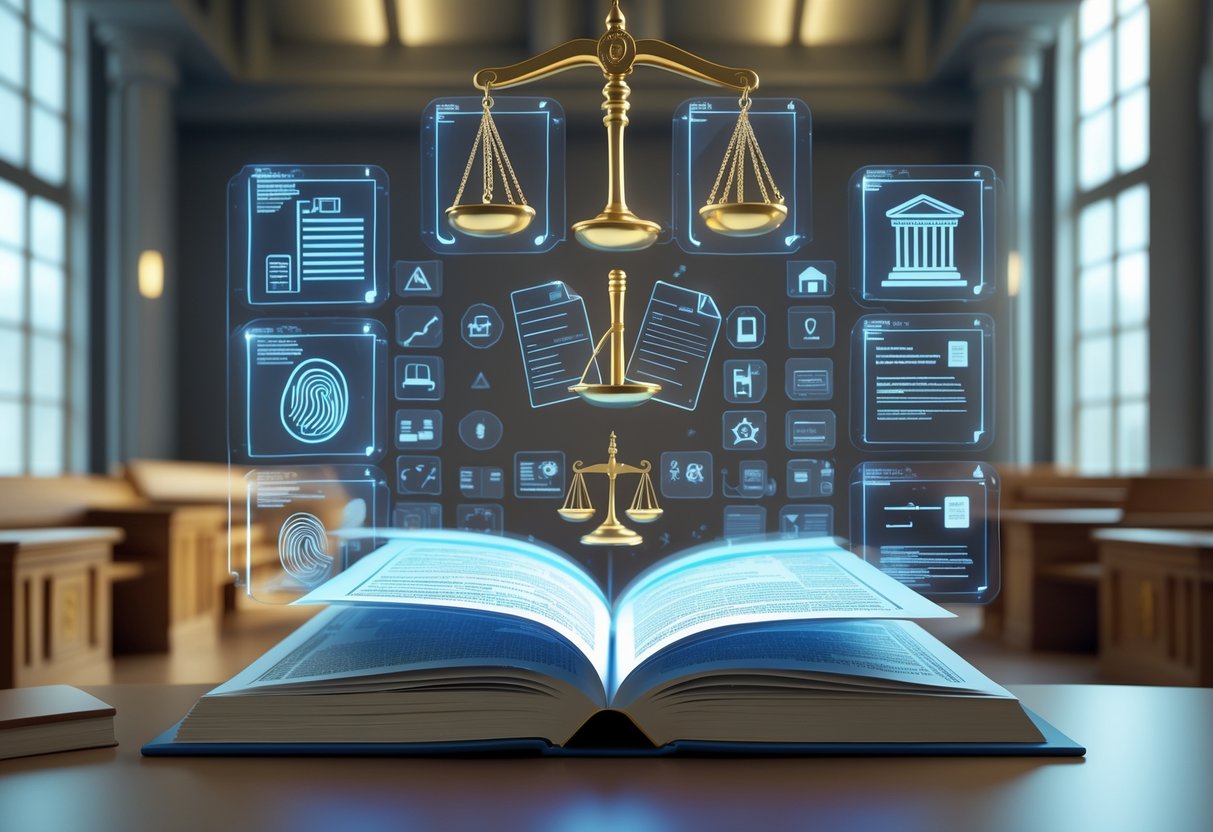
The Federal Rules of Evidence set the ground rules for what counts as evidence in court. Civil and criminal procedures each add their own requirements. Together, these frameworks aim to keep trials fair and evidence reliable.
Federal Rules of Evidence Overview
The Federal Rules of Evidence became law on January 2, 1975, when President Ford signed them. These rules control how courts handle evidence in federal cases across the U.S.
The rules cover five main areas:
- Judicial notice – facts the court can accept without proof
- Relevancy – whether evidence matters to the case
- Hearsay – statements made outside court
- Testimony – how witnesses speak in court
- Character evidence – showing someone’s reputation or behavior
| Rule Type | Purpose | Key Requirement |
|---|---|---|
| Relevance | Makes evidence useful | Must relate to case facts |
| Hearsay | Controls second-hand statements | Must have exception to be allowed |
| Authentication | Proves evidence is real | Must show it’s what it claims to be |
These rules apply in both civil and criminal federal cases. They help judges decide what evidence juries can hear and see.
The rules also set standards for witness credibility. Courts look at whether witnesses can be trusted to tell the truth.
Evidence Law in Civil Procedure
Civil procedure covers disputes between private parties, like contract fights or personal injury claims. The burden of proof is lower than in criminal cases.
In civil cases, evidence must hit the “preponderance of evidence” mark. One side just needs to show their story is more likely true than not.
Key civil evidence requirements:
- Documents must be properly authenticated
- Expert witnesses need the right qualifications
- Medical records require a proper foundation
- Electronic evidence needs a clear chain of custody
Civil cases tend to be a bit more flexible on certain evidence. Business records often get in more easily than in criminal trials. Settlement talks usually can’t be used as evidence.
Discovery rules let both sides gather evidence before trial—things like documents, depositions, and expert reports. This helps avoid nasty surprises in court.
Relevance still matters, but courts may allow evidence that helps settle disputes efficiently. The focus stays on fairness between parties rather than guarding against wrongful convictions.
Criminal Procedure and Evidence
Criminal procedure uses stricter evidence rules since someone’s freedom is on the line. The prosecution must prove guilt “beyond a reasonable doubt”—a much higher standard than civil cases.
Constitutional protections shape criminal evidence law:
- Fourth Amendment limits searches and seizures
- Fifth Amendment protects against self-incrimination
- Sixth Amendment guarantees the right to face accusers
The exclusionary rule blocks illegally obtained evidence from court. This covers evidence from unlawful searches or improper police questioning.
Special criminal evidence rules:
- Confessions must be voluntary
- Identification procedures must be fair
- Chain of custody must be maintained for physical evidence
- Miranda warnings required for custodial interrogation
Character evidence works differently in criminal cases. The prosecution usually can’t bring up a defendant’s past crimes unless the defendant brings it up first.
Witness protection rules get stronger in criminal matters. Courts sometimes allow anonymous testimony or closed hearings if witness safety is at risk.
Special Evidence Requirements in Criminal Cases
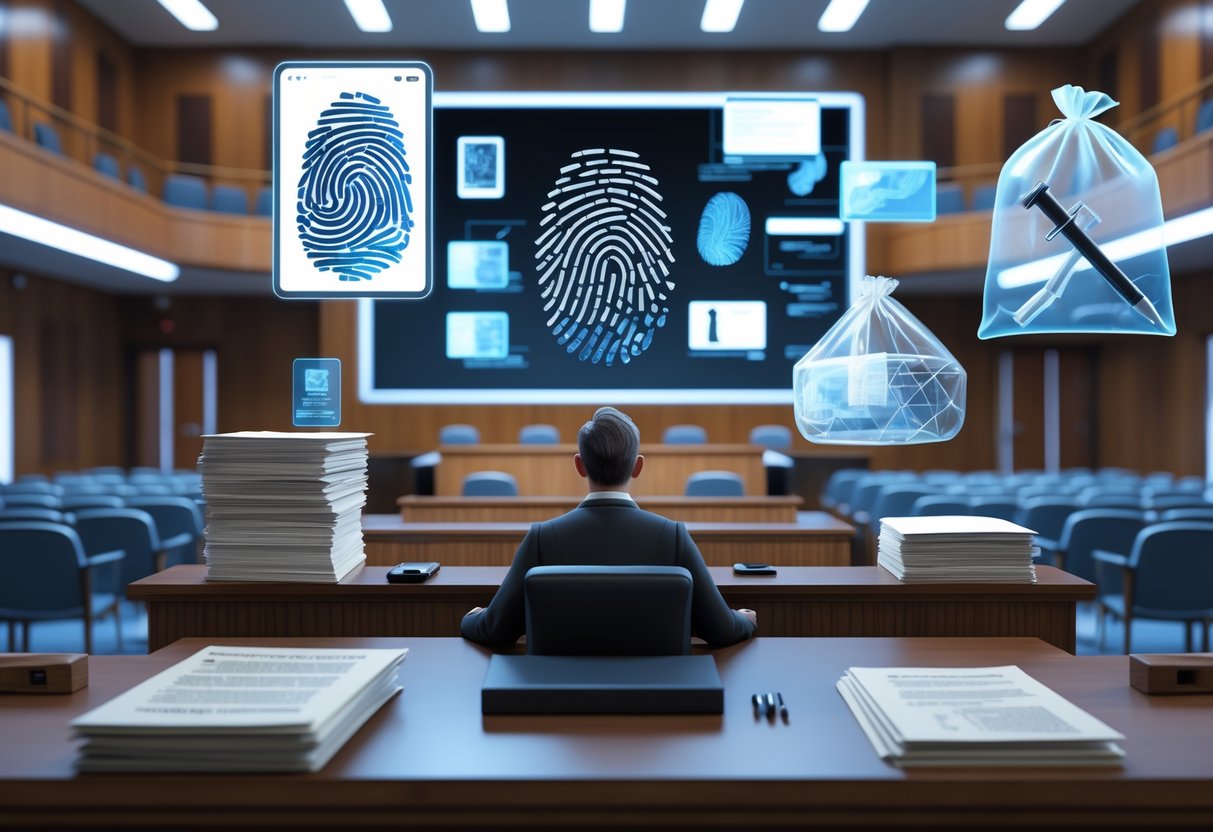
Criminal cases use stricter evidence standards than civil ones because defendants face serious consequences, even prison. The prosecution has to meet higher burdens of proof, and defendants get extra protections to keep trials fair.
Expert Testimony and Forensics
Expert testimony has become crucial in modern criminal cases. Courts ask expert witnesses to show specialized knowledge that helps juries understand tricky evidence.
Forensic evidence needs to meet tough admissibility standards. DNA, fingerprints, and ballistics all require a solid chain of custody. Each person who handles evidence records when and why they did so.
The prosecution has to show that forensic methods are scientifically reliable. This includes:
- Proper collection procedures
- Laboratory accreditation
- Qualified technicians
- Maintained equipment calibration
Digital evidence brings more challenges. Courts look closely at how electronic data was gathered, copied, and stored. Digital searches often require warrants.
Expert witnesses can’t just share opinions. They need to explain their methods and show how they got their results. The defense always gets to cross-examine expert testimony.
Role of the Prosecution
The prosecution must prove guilt beyond a reasonable doubt—a much tougher standard than the civil “balance of probabilities.”
Disclosure obligations run deep in criminal cases. Under Brady v. Maryland, prosecutors have to give the defense all exculpatory evidence.
This includes:
- Evidence that contradicts the prosecution’s case
- Information that could impeach prosecution witnesses
- Evidence that might reduce the defendant’s sentence
The prosecution can’t use perjured testimony. If they know—or should know—a witness is lying, they must correct it right away. Ignoring this breaks due process rights.
Chain of custody rules are strict. Prosecutors have to show unbroken custody of physical evidence from collection to trial. Gaps in documentation can get evidence thrown out.
Prosecutors keep these duties throughout the case. They must find out about favorable evidence known to police and share it with the defense, even if they didn’t know about it at first.
Rights of the Defendant
Defendants get a lot of protections in criminal cases. The right to remain silent stops prosecutors from forcing self-incrimination during arrest or trial.
Confession admissibility depends on strict safeguards. Statements must be voluntary and not coerced. Miranda warnings are usually required for custodial interrogations.
Defendants have the right to confront witnesses. This means they can cross-examine prosecution witnesses and challenge expert opinions. Courts won’t automatically throw out evidence just because it came from hypnosis or other controversial methods.
Discovery rights let defendants review prosecution evidence. When prosecutors say they’ve “opened their files,” defendants don’t need to make specific discovery requests, and broader disclosure kicks in.
The right to present a defense lets defendants call witnesses and introduce evidence. Sometimes, defendants have to give advance notice of certain defenses, like alibi claims. In those cases, courts require reciprocal discovery from the prosecution.
Defendants can testify for themselves, and courts can’t automatically exclude their testimony just because they refreshed their memory before trial.
Evidence in Civil Proceedings
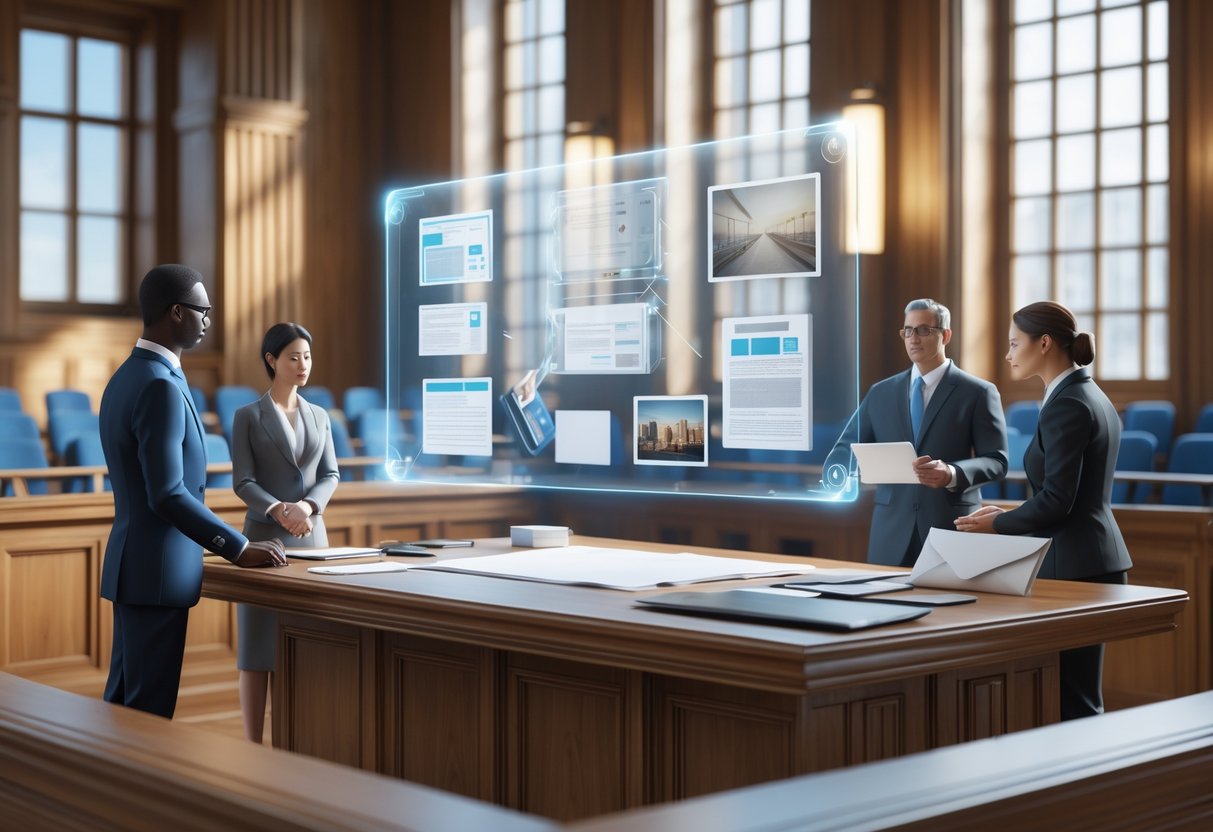
Civil cases require both the plaintiff and defendant to bring specific types of evidence to support their claims. The discovery process lets each party gather information before trial, and documentary evidence is usually the backbone of most civil litigation.
Claims of Plaintiff and Defendant
In civil proceedings, the plaintiff starts with the burden of proof. They need to show their claim is more likely true than not—a standard called “preponderance of the evidence.”
The plaintiff typically uses:
- Documents proving damages occurred
- Witness statements backing up their story
- Expert testimony to explain tricky issues
- Physical evidence linking the defendant to the harm
Defendants fight back by challenging the plaintiff’s evidence or offering their own. They might argue the plaintiff caused their own harm or point the finger at someone else.
Both sides must stick to strict rules about what evidence the court will accept. Evidence has to be relevant and reliable. Hearsay and prejudicial material usually get tossed out.
The judge decides if evidence meets these standards. Without proper evidence, even a strong claim can fall apart in court.
Discovery Process
Discovery lets both sides gather evidence before trial starts. This process keeps surprise attacks to a minimum and gives both parties a real sense of where they stand.
Common discovery methods include:
- Depositions — sworn testimony taken outside court
- Interrogatories — written questions that need written answers
- Document requests — demands for relevant papers and files
- Admissions — requests to admit certain facts are true
Courts set strict deadlines for finishing discovery. Miss a deadline, and you might lose the chance to use certain evidence at trial.
Each party has to preserve relevant documents as soon as litigation seems likely. If someone destroys evidence during this time, the court can hit them with harsh penalties.
Discovery often helps civil cases settle before trial. Once everyone sees the evidence, they usually have a pretty clear idea of what might happen in court.
Use of Documentary Evidence
Documents form the backbone of most civil lawsuits. Contracts, emails, financial records, and official reports tend to carry a lot of weight with judges and juries.
Key requirements for documentary evidence:
- Authentication — you need to prove the document is genuine
- Relevance — it has to matter to the case
- Best evidence rule — use originals when you can
Electronic evidence needs special handling. Metadata, deleted files, and digital timestamps sometimes become crucial. Courts now accept emails, texts, and social media posts as evidence all the time.
Business records get special treatment under evidence rules. Regular record-keeping by companies makes their documents pretty reliable in court.
Parties have to exchange key documents during discovery. If someone hides relevant papers, they can wreck their own case and face sanctions.
Witness Testimony and Cross-Examination
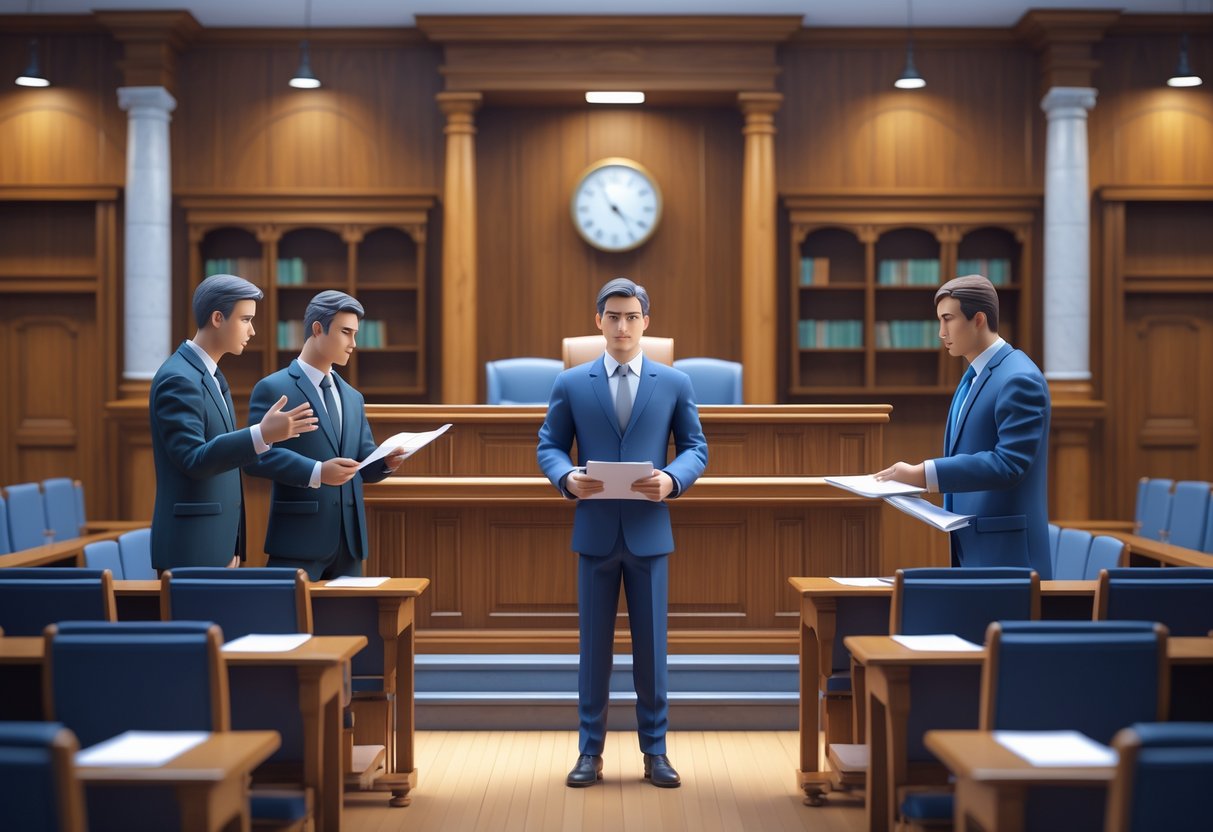
Witness credibility can make or break a case. Hearsay rules limit what secondhand statements get into evidence.
Cross-examination is how lawyers test witness reliability and poke holes in their stories.
Evaluating Witness Credibility
Credibility forms the backbone of witness testimony. Courts look closely at several factors to judge if a witness is reliable.
Consistency is huge. If a witness contradicts themselves between depositions and trial, their credibility drops fast. We watch for changes in their story.
Bias and interest can hurt a witness’s testimony. If someone stands to gain financially or has a close relationship with a party, judges and juries notice.
Memory and perception also matter. We think about things like:
- How far the witness was from the event
- Lighting conditions
- Stress levels at the time
- How much time has passed since the incident
Cross-examination lets lawyers test these credibility factors directly. By asking pointed questions, they expose inconsistencies or bias. Leading questions can help control a stubborn witness.
Prior inconsistent statements are powerful. If a witness said something different earlier, we can use that to challenge their story now.
Hearsay and Its Exceptions
Hearsay rules block most secondhand statements from evidence. The whole point is to stop witnesses from testifying about what someone else said outside court.
Rule 803 carves out important exceptions. Some out-of-court statements are considered reliable enough to allow in.
Present sense impressions under Rule 803(1) qualify. If someone describes an event as it’s happening, that’s usually trustworthy. For example, a witness can testify that someone yelled, “He’s running the red light!” during an accident.
Excited utterances under Rule 803(2) let in statements made during stressful events. Stress makes lying less likely. Emergency calls often have admissible excited utterances.
Business records under Rule 803(6) come in all the time. These include:
- Medical records
- Police reports
- Maintenance logs
- Financial statements
Public records under Rule 803(8) get in easily. Government documents like birth certificates and inspection reports are good examples.
State of mind exceptions under Rule 803(3) allow statements about someone’s mental condition. “I’m scared of John” shows fear, not necessarily that John did anything wrong.
Privilege and Exclusions in Evidence Law
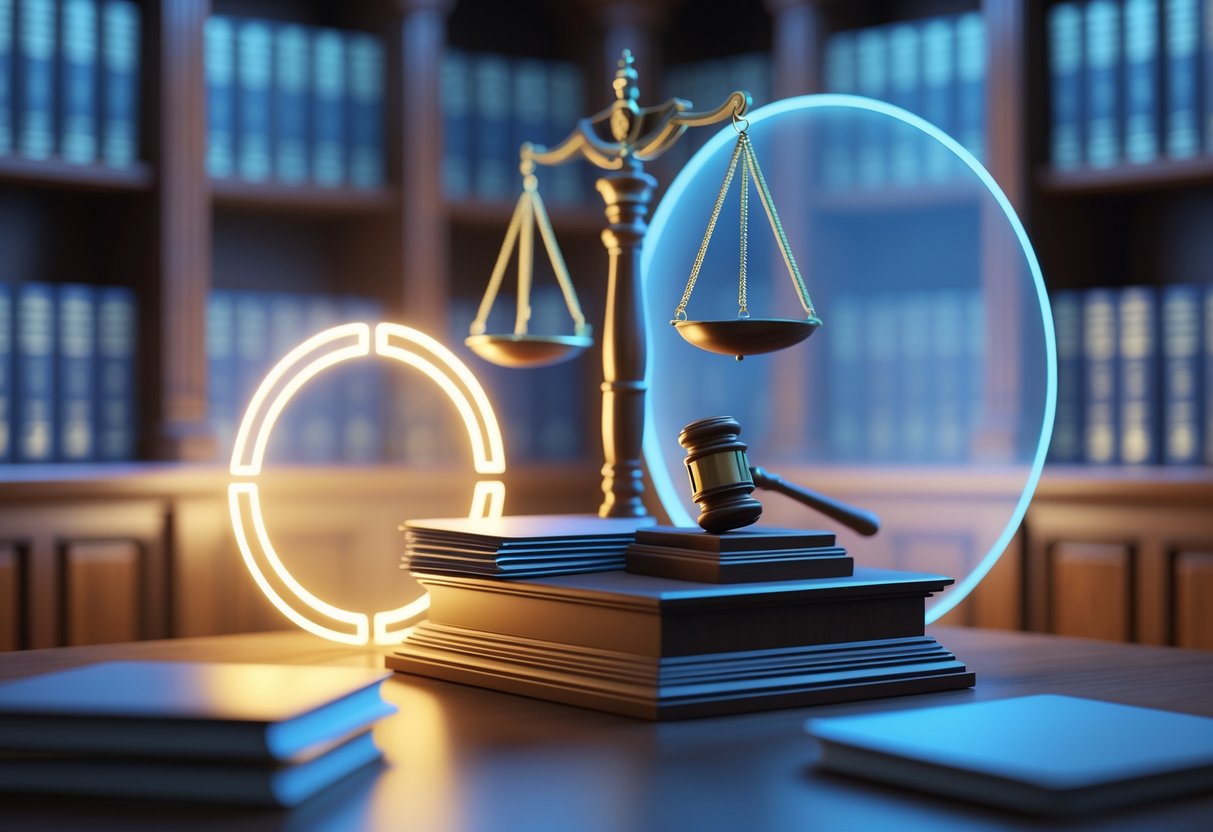
Courts recognize certain legal protections that keep some information out of evidence, even if it’s relevant. These privileges protect important relationships and make sure legal proceedings stay fair by letting people keep confidential communications private.
Attorney-Client Privilege
Attorney-client privilege protects what clients say to their lawyers. This rule encourages people to speak honestly with their attorneys without worrying their words will show up in court later.
The privilege covers confidential communications made for legal advice. It applies to conversations, letters, and electronic messages between lawyer and client.
Key Requirements:
- Communication must be confidential
- Happens between attorney and client
- Made to get legal advice
- Client intends it to stay private
The client owns the privilege, not the lawyer. Only the client can decide to give up that protection.
Important Exceptions:
The crime-fraud exception wipes out privilege if the communication helps commit a crime or fraud. If a client asks a lawyer for help with future illegal acts, those talks aren’t protected.
Courts also make exceptions for joint clients or when a dispute comes up between lawyer and client.
Judicial Notice
Judicial notice lets courts accept certain facts as true without formal proof. This speeds things up by skipping evidence for facts everyone knows or can easily check.
Courts can take judicial notice of facts that are generally known in the community or can be verified from reliable sources.
Two Types of Facts:
Adjudicative facts relate to the actual case—things like dates, locations, or scientific principles that aren’t really up for debate.
Legislative facts help courts interpret legal rules and understand the bigger picture. These might touch on social or economic trends that shape the law.
Common examples include calendar dates, distances between cities, or basic science. Courts might take judicial notice that London is England’s capital or that water freezes at 0°C.
Mandatory vs Discretionary:
Courts have to take judicial notice if a party asks and provides the right info for indisputable facts. For other facts, it’s up to the court.
Parties can ask for judicial notice and get a chance to argue about whether it’s appropriate and what the fact actually is.
Evidence Requirements in Social Security and Government Proceedings
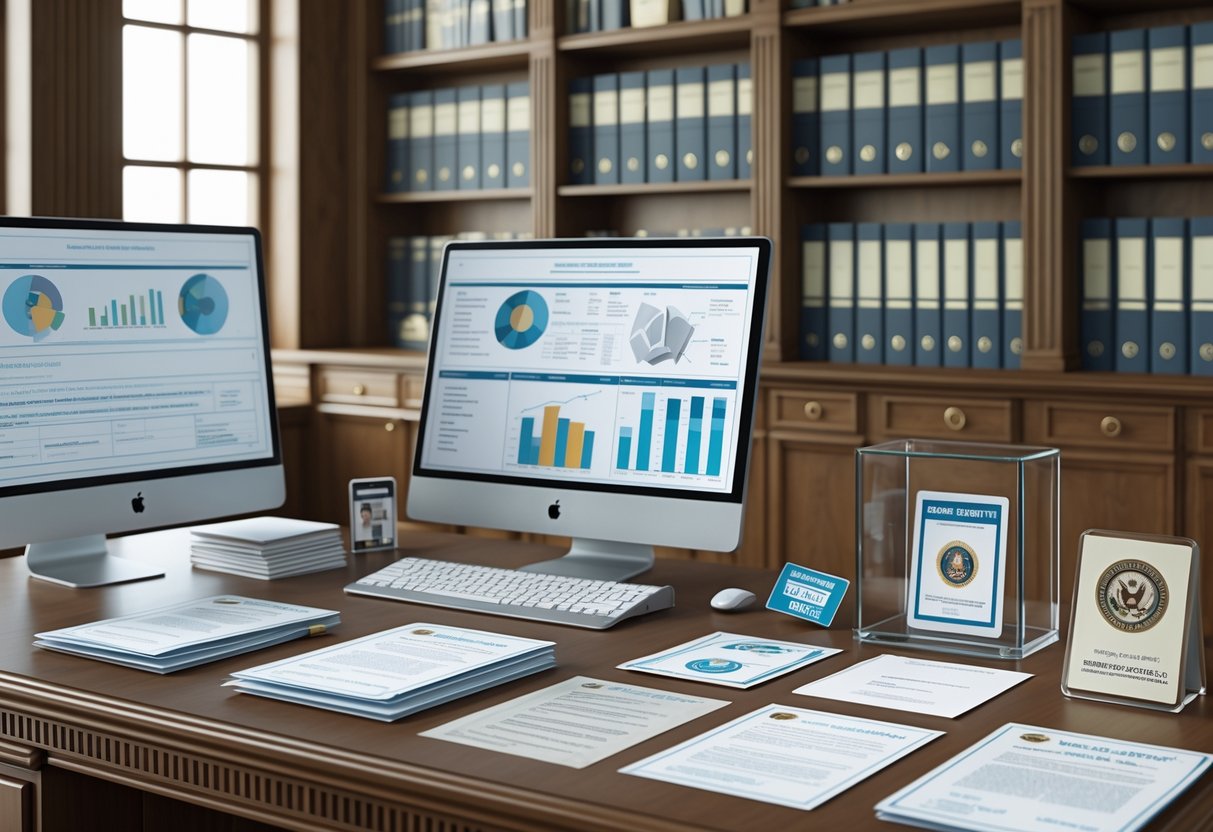
The Social Security Administration (SSA) needs specific evidence to prove disability claims. They look at medical records, test results, and expert opinions using strict standards to decide if someone qualifies for benefits.
SSA Disability Claims
The SSA wants complete medical evidence to make disability decisions. This means records from doctors, hospitals, and clinics that show your condition and how it affects your daily life.
Medical evidence must be:
- Recent enough to show your current condition
- Detailed enough for someone else to review
- From acceptable medical sources
You need to provide proof of a medically determinable impairment (MDI). The SSA checks for:
- Objective medical findings from exams
- Lab results and diagnostic imaging
- Treatment records showing ongoing care
- Functional assessments of daily activities
The evidence has to cover the right time period for your claim. If you’re claiming disability from January 2024, records from 2022 probably won’t cut it by themselves.
If you don’t give enough evidence, the SSA can’t make a decision. They might ask for more records or order a consultative exam.
Consultative Examinations
A consultative examination (CE) is a medical exam the SSA orders when the evidence is missing or doesn’t add up. These exams help clear up conflicting medical opinions.
The SSA orders a CE when:
- Medical evidence conflicts with other records
- Records have contradictions
- Evidence is too old to show your current condition
- Key information is missing
An independent medical professional, picked by the SSA, does the CE. If you skip this exam, you could lose your claim for not cooperating.
What happens during a CE:
- Physical exam focused on your condition
- Review of your medical history
- Functional capacity assessment
- Written report sent to SSA
The CE examiner offers an independent medical opinion. The SSA considers this along with the rest of your records.
Agency Standards for Evidence
The SSA has strict rules for what counts as acceptable evidence and how they look at it. All evidence needs to relate to the issues in your claim.
Evidence categories include:
- Medical evidence from acceptable sources
- Non-medical evidence about daily functioning
- Vocational evidence about work history
- Prior administrative findings
| Evidence Type | Requirements | Purpose |
|---|---|---|
| Medical records | From licensed providers | Establish medical conditions |
| Test results | Medically acceptable techniques | Support diagnostic findings |
| Work history | Detailed job descriptions | Assess past relevant work |
| Daily activities | Specific functional examples | Show impact of conditions |
The SSA checks evidence for consistency and sufficiency. Materially inconsistent evidence can make or break your claim. When records conflict, the SSA might need more information.
Key evaluation factors:
- How well medical opinions are supported
- Consistency with other evidence
- Relationship between source and claimant
- Specialization of the medical source
If evidence is still lacking after reasonable effort, the SSA decides based on what’s available using their step-by-step process.
Frequently Asked Questions

Here are some common questions about evidence requirements. Knowing what documents you need and how to send them can save time and avoid headaches.
What documents are needed to support the I-485 application for a spouse?
You’ll need a marriage certificate as your main proof. Make sure it’s a certified copy from the office where you got married.
Birth certificates for both spouses are also required. Get official government-issued documents with raised seals.
Financial documents show you can support your spouse. Include Form I-864 Affidavit of Support with tax returns for the last three years.
You’ll need medical exam results from a USCIS-approved doctor. Only schedule this after you get your appointment notice.
Could you tell me which materials serve as acceptable proof for an I-129 petition approval?
Your employer should provide a detailed job offer letter. It needs to include salary, job duties, and start date.
You’ll need your educational credentials evaluated by a recognized agency. Attach degree certificates and professional qualifications.
Company registration documents prove your employer is legit. Submit articles of incorporation and business licenses.
Letters from past employers about your work experience help a lot. These should be on company letterhead with contact info.
What distinguishes a Request for Initial Evidence from a standard Request for Evidence in the USCIS process?
A Request for Initial Evidence (RFE) means USCIS needs something you forgot to include. This usually happens when required evidence is missing from your original application.
A standard Request for Evidence asks for extra proof to support your case. This comes up when they need more than just the basics.
Response times aren’t always the same. Initial evidence requests typically give you 87 days, while standard RFEs might have different deadlines.
If you don’t respond to either type, your case gets denied. Always send a complete response before time runs out.
What kinds of evidence are required when responding to a USCIS I-130 Request for Evidence?
You’ll need relationship evidence to prove your family connection. Use birth certificates, marriage certificates, or adoption papers as needed.
Financial documents show you can support your relative. Submit tax returns, employment letters, and bank statements.
For identity, provide government-issued photo ID. Passport copies or driver’s licenses for everyone involved are best.
Communication records can show an ongoing relationship. Letters, emails, or phone records from several months help.
Can you provide a checklist of items necessary for an I-485 application submission?
Fill out and sign Form I-485. Double-check that every section is complete.
Include two passport-style photos taken within 30 days. Follow the USCIS photo requirements.
Send a copy of your current passport and any old ones. Include all pages with stamps or visas.
Attach your birth certificate with a certified English translation if needed. It must be official.
If you’re applying based on marriage, include your marriage certificate. Also add divorce decrees from previous marriages.
Get Form I-693 medical exam done by a USCIS-approved doctor. Make sure it’s less than 60 days old when you submit.
What medical evidence is essential when submitting an initial evidence request for an I-485 application?
You have to include Form I-693, the Report of Medical Examination and Vaccination Record. A USCIS-designated civil surgeon needs to fill this out.
Bring vaccination records that show your immunizations are up to date. USCIS usually asks for vaccines like measles, mumps, rubella, and polio, among others.
If you have a history of mental illness, you might need a mental health evaluation. The civil surgeon decides if you’ll need this extra assessment.
Include your test results for communicable diseases. They’ll check for tuberculosis, syphilis, and gonorrhea as part of the standard screening.
